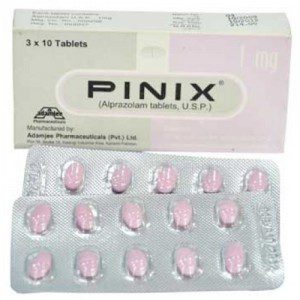Pinix (Alprazolam) 1mg
$0.50
Pinix (Alprazolam) 1mg pills/tablets:
Pinix (Alprazolam) treats anxiety, panic disorder, insomnia (trouble sleeping), and anxiety caused by depression. This medicine is a benzodiazepine.
You can buy Pinix (Alprazolam) 1mg tablets online without prescription (No RX).
product price is as: per pill
Minimum order quantity is: 100 pills

Pinix is a popular medication that contains Alprazolam as its active ingredient. Alprazolam is a benzodiazepine that is primarily used to treat anxiety disorders, panic attacks, and depression. Pinix is available in different strengths, including 1mg, which is a common dosage for managing anxiety symptoms. This article aims to provide comprehensive information about Pinix 1mg, its uses, side effects, and precautions.
Uses of Pinix 1mg
Pinix 1mg is primarily used to treat anxiety disorders, including generalized anxiety disorder (GAD) and panic disorder. GAD is characterized by excessive worry and tension that lasts for six months or longer, while panic disorder is characterized by recurring unexpected panic attacks. Pinix 1mg can also be used to treat depression, especially when it is accompanied by anxiety.
How Pinix 1mg Works
Pinix 1mg works by increasing the activity of gamma-aminobutyric acid (GABA), a neurotransmitter that inhibits the activity of nerve cells in the brain. This results in a calming effect, reducing anxiety and promoting sleep. Alprazolam, the active ingredient in Pinix 1mg, has a rapid onset of action, typically within an hour of ingestion, and its effects can last for up to six hours.
Side Effects of Pinix 1mg
Like all medications, Pinix 1mg can cause side effects. Common side effects include drowsiness, dizziness, lightheadedness, and dry mouth. Less common side effects include constipation, diarrhea, nausea, and changes in appetite. In rare cases, Pinix 1mg can cause more serious side effects, such as memory problems, mood changes, and difficulty breathing. If you experience any of these side effects, contact your healthcare provider immediately.
Precautions and Warnings
Pinix 1mg should be used with caution in certain populations. The medication can cause drowsiness and dizziness, so it should not be taken with alcohol or other sedatives. Pinix 1mg can also cause dependence and withdrawal symptoms, so it should not be stopped suddenly without consulting your healthcare provider. Additionally, Pinix 1mg should be used with caution in pregnant women, as it can cause harm to the developing fetus.
Interactions with Other Medications
Pinix 1mg can interact with other medications, including antidepressants, antihistamines, and opioids. These interactions can increase the risk of side effects, such as drowsiness and respiratory depression. Before taking Pinix 1mg, tell your healthcare provider about all the medications you are taking, including over-the-counter drugs and supplements.
Dosage and Administration
Pinix 1mg is typically taken orally, with or without food. The dosage will depend on your individual needs and the severity of your symptoms. Your healthcare provider will determine the appropriate dosage for you, based on your age, weight, and medical history. It is important to follow your healthcare provider’s instructions carefully and not to increase or decrease your dosage without consulting them first.
Conclusion
Pinix 1mg is a valuable medication for managing anxiety disorders, panic attacks, and depression. However, like all medications, it should be used with caution and under the guidance of a healthcare provider. If you have any questions or concerns about Pinix 1mg, talk to your healthcare provider or pharmacist. By using Pinix 1mg responsibly and following your healthcare provider’s instructions, you can achieve effective relief from your symptoms and improve your quality of life.
Related products
ANTI ANXIETY
ANTI ANXIETY
ANTI ANXIETY
ANTI ANXIETY
ANTI ANXIETY
ANTI ANXIETY
ANTI ANXIETY
ANTI ANXIETY











